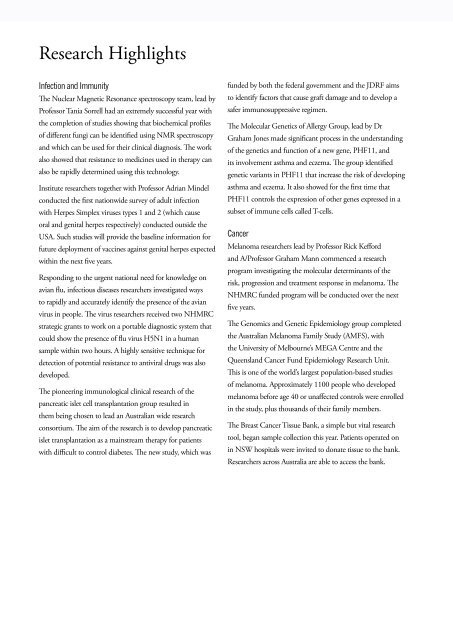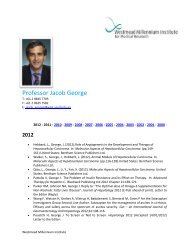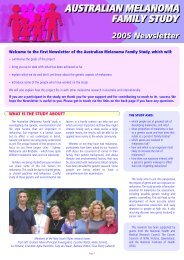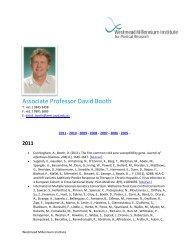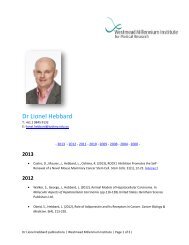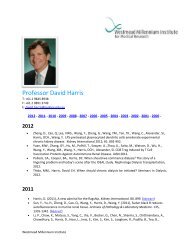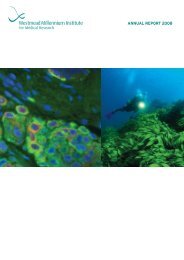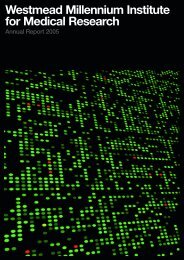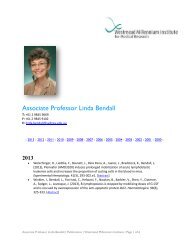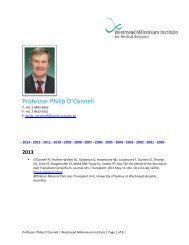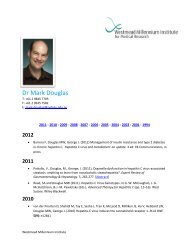Translating >> - Westmead Millennium Institute
Translating >> - Westmead Millennium Institute
Translating >> - Westmead Millennium Institute
- No tags were found...
You also want an ePaper? Increase the reach of your titles
YUMPU automatically turns print PDFs into web optimized ePapers that Google loves.
08 09 > Overview // AR 2006<br />
Research Highlights<br />
Infection and Immunity<br />
The Nuclear Magnetic Resonance spectroscopy team, lead by<br />
Professor Tania Sorrell had an extremely successful year with<br />
funded by both the federal government and the JDRF aims<br />
to identify factors that cause graft damage and to develop a<br />
safer immunosuppressive regimen.<br />
Liver and Metabolic<br />
Dr Poustchi was the recipient of a Young Investigator<br />
award at the Asia Pacific Digestive Disease Week in Cebu,<br />
The Brain Dynamics Centre capped a successful year with<br />
the opening of their newly refurbished facilities. The Baroness<br />
Susan Greenfield officially opened three new laboratories.<br />
the completion of studies showing that biochemical profiles<br />
of different fungi can be identified using NMR spectroscopy<br />
and which can be used for their clinical diagnosis. The work<br />
also showed that resistance to medicines used in therapy can<br />
also be rapidly determined using this technology.<br />
<strong>Institute</strong> researchers together with Professor Adrian Mindel<br />
conducted the first nationwide survey of adult infection<br />
with Herpes Simplex viruses types 1 and 2 (which cause<br />
oral and genital herpes respectively) conducted outside the<br />
USA. Such studies will provide the baseline information for<br />
future deployment of vaccines against genital herpes expected<br />
within the next five years.<br />
Responding to the urgent national need for knowledge on<br />
avian flu, infectious diseases researchers investigated ways<br />
to rapidly and accurately identify the presence of the avian<br />
virus in people. The virus researchers received two NHMRC<br />
strategic grants to work on a portable diagnostic system that<br />
could show the presence of flu virus H5N1 in a human<br />
sample within two hours. A highly sensitive technique for<br />
detection of potential resistance to antiviral drugs was also<br />
developed.<br />
The pioneering immunological clinical research of the<br />
pancreatic islet cell transplantation group resulted in<br />
them being chosen to lead an Australian wide research<br />
consortium. The aim of the research is to develop pancreatic<br />
islet transplantation as a mainstream therapy for patients<br />
with difficult to control diabetes. The new study, which was<br />
The Molecular Genetics of Allergy Group, lead by Dr<br />
Graham Jones made significant process in the understanding<br />
of the genetics and function of a new gene, PHF11, and<br />
its involvement asthma and eczema. The group identified<br />
genetic variants in PHF11 that increase the risk of developing<br />
asthma and eczema. It also showed for the first time that<br />
PHF11 controls the expression of other genes expressed in a<br />
subset of immune cells called T-cells.<br />
Cancer<br />
Melanoma researchers lead by Professor Rick Kefford<br />
and A/Professor Graham Mann commenced a research<br />
program investigating the molecular determinants of the<br />
risk, progression and treatment response in melanoma. The<br />
NHMRC funded program will be conducted over the next<br />
five years.<br />
The Genomics and Genetic Epidemiology group completed<br />
the Australian Melanoma Family Study (AMFS), with<br />
the University of Melbourne’s MEGA Centre and the<br />
Queensland Cancer Fund Epidemiology Research Unit.<br />
This is one of the world’s largest population-based studies<br />
of melanoma. Approximately 1100 people who developed<br />
melanoma before age 40 or unaffected controls were enrolled<br />
in the study, plus thousands of their family members.<br />
The Breast Cancer Tissue Bank, a simple but vital research<br />
tool, began sample collection this year. Patients operated on<br />
in NSW hospitals were invited to donate tissue to the bank.<br />
Researchers across Australia are able to access the bank.<br />
Philippines 2006, for related research on insulin resistance<br />
and responses to antiviral therapy in patients with Chronic<br />
hepatitis C.<br />
In the area of insulin resistance and liver disease, Dr Ian<br />
Cua a Clinical Research Fellow won the Unit’s second<br />
Young Investigator Award at the Asian Pacific Association<br />
for the Study of the Liver meeting (March 2006) in Manila,<br />
Philippines, for his studies on the role of adipokines in<br />
mediating insulin resistance in hepatitis C.<br />
Neuroscience and Vision<br />
Researchers in the Centre for Vision Research in conjunction<br />
with the University of Sydney, used data from the Blue<br />
Mountains Eye Study to investigate dietary fat and its<br />
relationship to this eye disease. They found that people who<br />
consumed one serve of fish a week had a 40% lower risk of<br />
developing the early form of age-related maculopathy (ARM)<br />
and people who consumed three serves of fish a week had a<br />
75% lower risk of developing the more severe form of ARM.<br />
A PhD project titled: Conscious and Nonconscious Emotion<br />
processing: An integration of fMRI and ERPs was recognized<br />
by the award of best PhD thesis for this year (winning the<br />
Tasman Lovell medal in Psychology). It identified the neural<br />
signature of conscious and nonconscious processing of fear<br />
and happiness.<br />
Cardio-respiratory<br />
During 2006 LECRR researchers completed a major<br />
epidemiologic study that identified heavy snoring as a risk<br />
factor for the presence of carotid artery wall atherosclerosis<br />
(plaque). Since dislodgement of carotid artery wall plaque is a<br />
cause of stroke, this finding suggests that heavy snoring alone<br />
poses a significant health threat.<br />
A project conducted by the Centre for Heart Research<br />
involved the creation of a chronic ovine (sheep) model of<br />
atrial flutter using purely percutaneous (through the skin)<br />
means. Previous models required open heart surgery. With<br />
the aid of new 3D electro-anatomical imaging, the group was<br />
able to reliably induce atrial flutter in sheep, similar to the<br />
abnormal heart rhythms experienced by humans. Gene and<br />
stem cell therapy to treat such disorders of the conduction<br />
system of the heart will commence in late 2007.


